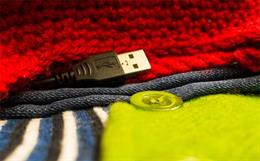Fashion is embracing technology like never before. Here's everything you need to know about smart textiles and how technology is reshaping the textiles and apparel industry.
The fashion world is changing inside out, and technology is adding more perks to the new fashion. We are living in an era where technology has revamped almost everything around us and fashion is the next new thing.
Technology in wearables is no more limited to smartwatches and fitness trackers. Technology has come a long way to smart textiles. Gone is the time when monitoring and tracking fitness-related metrics-steps counts, walked distance, calorie consumption, quality of sleep and heartbeat rate used to drive people crazy. Today's generation is looking for more, more and more.
Smart textiles is ready to add more power to humans. These fabrics are designed to regulate body temperature, reduce wind resistance, and control muscle vibration-all of which boosts the athletic performance. More than that, these fabrics can also work as protective clothing to guard you against extreme environmental hazards such as radiation and the effects of space travel.
Interesting! Isn't it?
Smart textiles are the most astonishing innovation of the textiles and clothing industry. Beyond everyone's imagination-smart textiles are here to blow your mind. Billy Whitehouse, co-founder of Wearable Experiments-a company integrating fashion and technology-says, "As things get smaller and cheaper and faster integration becomes easier, I see fashion and technology becoming one."
Smart textiles are driven by intelligence where fabrics can sense and analyse a singular element and respond in an intelligent way. 'Fashion with Features' is ready to add more style to the word of textiles. Here's all that you need to know.
1) Types: Broadly smart textiles can be broken into two categories: aesthetic and performance enhancing.
Aesthetic: Textiles that use technology for fashion and design purpose to bring lights and sounds into the world of textiles. They also gather energy from the environment to harness vibrations, sound or heat, reacting to this input.
Performance enhancing: These textiles use technology to assist human athletic function like jogging and extreme sports by monitoring body temperature and adjusting the breathability of the fabric.
2) Functionalities: Many functions together are making fabrics smarter than ever before. The major ones:
Sensors: Smart textile have sensors injected to detect the environment and respond in a suitable manner. Fabrics are excellent measuring tools for human senses as they cover our body. For real devices, bio-signals need to be transformed into electric ones and this is
what a sensor does. A few materials have the capability of transforming biosignals to electric ones-thermocouple, soft switch technology, and Fibre Bragg Grating (FBG) sensor.
Data processor: Smart textiles need data processing only when active processing is imperative. At present, data decoding is the bottleneck. Sensors used in the textiles are
ready to provide data but what do they mean is yet to be discovered. Apart from the interpretation of data, the other major concern is the computing power of fabrics. As fabrics don't have any computing power, pieces of electronics become a vital part of smart textiles. However, they are available in miniaturised and even in flexible form and embedded in waterproof material, but durability is still a question. To overcome all these challenges, researchers are working towards fixing the active components on fabrics.
Actuators: After receiving signals from the sensor and interpreting them by a data processor, fabrics need a response. Actuators back-talk the impulse signal by making things move; they release substances, make noise and do the needful. The best actuators used in tech-textiles are shape memory materials and alloys exist in the form of threads. Shape memory materials can react to temperature changes and that's what makes them transform thermal energy into motion. In smart textiles, shape memory alloy is woven with traditional textile material resulting in a fabric with a pure textile aspect.
Storage: Often, smart textiles need some storage capacity to store data and energy. All functions-sensing, data processing, actuation, and communication-need some energy: electrical power. To manage this energy, fabrics need a combination of energy supply and energy storage capacity. Currently, the textiles industry is using lithium-ion batteries in many applications but for some operations where large temperature variation occurs, it can be used to store thermal energy as well. The same task can also be attained by phase change materials (PCMs).
Communication: Smart textiles need to communicate at every single stage-within an element, between individual elements, and with the fabric. The industry is using optical fibres or conductive yarns to allow communication within the smart textiles as they both have a textile nature and can be built in the fabric. They also use a flexible textiles screen to communicate with the wearer. With the wider environment, wireless communication is the only way as it doesn't allow direct contact. Antennas are integrated with fabrics to attain wireless communication. Brighter side: antennas can cover the large surface without users being aware of it.
3) Classification: Smart textile are working on three major classifications: passive smart textiles, active smart textiles, and ultra-smart textiles.
Passive smart textiles: The first generation of smart textiles can only perceive the data about the stimuli of the environment. Passive smart textiles only have sensors. No matter what environment you are into, UV (ultra-violet) protective clothing, plasma treated clothing, and fabric with optical sensor-all will perform the same function they are designed for, irrespective of the environment.
Active smart textiles: The second generation of smart textiles-active smart textiles-comprises both sensors and actuators. They can adapt their functionality according to the environment. Also, they can memorise the shape, regulate temperature, absorb vapours, keep the chameleon effect, resist water, heat fabric of the suit and store it.
Ultras-smart textiles: The advanced fabrics of all time are ultra-smart textiles and the most intelligent one too. These fabrics can sense disparate data types, make forecasts and fit the external environment without preliminary tuning. They have a built-in micro-computer to make them work like the brain. This collaboration between technology and textiles is incredible.
4) Applications: These intelligent textiles are worn as ordinary clothes with super-advanced features. Depending on the purpose they are designed for, here are a few industries they are serving amazingly.
Health: Smart textiles have come a long way to take care of our health. Now, there are wearable devices that can monitor the physiological signal during daily routine activities. Wireless-enabled garments with embedded textile sensors can continuously monitor ECG, respiration, EMG and physical activity of patients. Wearable sensitised garments can measure humans' heart rhythm and respiration using a three-lead ECG shirt. The conductive grid and sensors are fully integrated within the fabric.
Medical: Smart textiles have given two superpowers: life belt and life jacket. A life belt is a trans-abdominal wearable device to monitor health long term. It facilitates parental monitoring for both the foetus and the mother. Also, it's a support tool for an obstetrician who is enabled to monitor patients remotely. A life jacket helps patients read their blood pressure and monitor their heart rate. Then, the information is sent to the medical staff to check on the progress of the patient's health.
Military/defence: Everywhere in the world, military forces are exploring smart textiles to increase their safety and add more to their power. Smart textiles assist them in a hazardous situation by monitoring vital signs and also ease injuries. Wireless communication enables medics to conduct a remote triage of causalities to help them respond rapidly and safely. Smart textiles increase their protection and boost their performance.
Sportswear: Smart textiles are chasing sports at their best. Apart from monitoring and tracking physiological parameters, smart textiles provide 'smart' resistance training, and record aspects of performance and protection against injuries. A global positioning System (GPS) is unified with walking shoes to track the wearer, especially young children. Moreover, smart bras can change their properties in response to breast movements. They can also tighten or loosen the straps with ease and relax cups to restrict breast motion, preventing breast pain and sag. Smart sportswear is amazing.
Fashion and entertainment: A new tech world has made almost everything portable. These portable electronic devices and components are infused in clothes used in fashion and entertainment. While technology is hidden through the coating and advance dazzling effects, light emitting fabric is finding its way into haute couture catwalks, suggesting a future trend in technical textiles.
Takeaways: Smart textiles have given a new vision to the textiles industry. Technology is uncovering new possibilities of the textiles world. The match of 'Tech & Tex' will take clothes beyond our imagination. Be ready to meet a more intelligent wearer in the future.



_Small.jpg)




